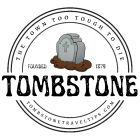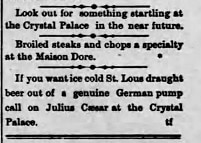
The Crystal Palace history in Tombstone is the example of authentic Saloon history in Tombstone Arizona. The corner of 5th and Allen Street developed as the same saloon in one way or another. Reinventing itself since 1800.
Another Crystal Palace being built in the 1800s likely influenced its naming. In London, built for the very first World’s Fair – it was a famed palatial building. When it burned down in 19366, it made news throughout the country. Many people in this “New World” were still impressed and influenced by the goings on in Europe. So to name this Saloon, which was planned to also be impressive, for this European edifice, wouldn’t be unusual. In fact many more Crystal Palace namings would occur throughout the U.S. during the 1800s and beyond!
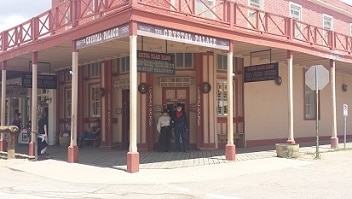
But we love it there! At the Tombstone’s Crystal Palace. For the authentic history. You’re invited to come enjoy it. Do you love old West history? Re-live it here. The Crystal Palace history comes alive in Tombstone, Arizona.
What is it about Tombstone’s Crystal Palace history that makes it special? Let’s see:
- Originated in 1879 as the Golden Eagle Brewery
- Burnt down in the devastating 1882 town fire, but was soon rebuilt in the same spot as the renamed Crystal Palace Saloon
- Reinvented itself for awhile as a theater
- After prohibition, back in business as a restored saloon!!
- Still open today: as the historic Crystal Palace Saloon
For you to have a Good Meal & a Great Time!
Crystal Palace History
Through the Years
Plans In the Works
The Tribolet brothers were immigrants from Ertach, Berne, Switzerland. Seven brothers, but three instrumental to this history.
The oldest was Godfrey. He moved to Charleston, Arizona Territory. Becoming a journeyman butcher, he learned the business, began saving funds. With bigger plans in his head!
Godfrey moved to Tombstone, a growing community. He opened a butcher market at the corner of Allen and 5th Street. His two younger brothers joined the business. Manfred was a cooper, 10 years younger. Charles one year younger
Charles was confident in Tombstone’s future, and his place in it. A June 15, 1880 record shows he purchased a deeded lot in the block south of the Golden Eagle, between 4th and 5th Streets.

Grand Opening: Beef & Beer
Godfrey specialized in alcoholic drinks and beef products. By late 1879 he involved Bernhardt Wehrfritz: a German brew-master, who ended up the long-term owner. Godfrey set up his corner with an adjacent business: The Golden Eagle Brewery.1
They did a roaring business. The brewery became the beer wholesalers for Southeastern Arizona. A dozen bottles sold for $3, wholesale whiskey from $2 to $8 a gallon, depending on brand, and mescal for $4 a gallon.

The Golden Eagle had a lunch counter. Convenient with their butcher shop adjacent, plus patrons could order beverages. A popular place for locals!
[By the way – it still is!]
Such quick success! Did they handle their funds efficiently? That old time method of putting it under the mattress or under the bed?!! Is that what they meant by “under the house”?

First Tombstone Fire
In mid 1881 a serious fire lit through Tombstone’s business district. From East of the Golden Eagle Brewery, spreading West toward the Brewery corner.
On the opposite corner stood the Vizina and Cook building, with the exquisite Oriental Saloon. Much effort went into trying to save the Oriental. That probably helped staving flames from jumping the street to the Golden Eagle. For the moment it was spared.
But then – June 1881
Clipping: Detroit Free Press (6/24/1881)…

Golden Eagle Business Continues!
The evening of February 26, 1882 Ben Wehrfritz found his bartender, Mr. Forster, out front of the Golden Eagle fighting with a local man. Ben went outside breaking it up.
A lawman entered arresting the two causing the fracas. Ben just wanted his bartender back inside. It didn’t work out! See how that ended up, in this Tombstone Epitaph article:

By Spring 1882, Ben’s business still rolled along. He made it a unique and desirable establishment. A quality gathering spot. Note this report in the Tombstone Epitaph of April 24, 1882. Ben advertised regularly in local publications, highlighting the Golden Eagle Brewery’s quality.

Tombstone Fire of May 1882
Midway between 4th and 5th Streets, on the North side of Allen, a fire flamed up behind the Tivoli Gardens Saloon. It was May 26, 1882, mid-afternoon. Quickly spreading Eastward throughout the whole block. All the wooden framed businesses began crackling in the flames.
The Golden Eagle Brewery wasn’t spared this time. Most of the business area was burnt away. Only a few buildings were saved by hard working people moving bucket brigades.
[Click on News Articles to Enlarge & Read]



The May 27, 1882Epitaph reported: “Smoke from the fire rose from the ruins for several days.” Everyone in town kept optimistic, determined to rebuild.
Including Golden Eagle proprietors. Ben Wehrfritz was completing his new building on the corner of Allen and 5th Streets. On Friday, June 23rd, a worker was injured.

Downtown Tombstone Rebuilding
By April, everyone busied making Tombstone a thriving community once more. Tombstone’s efforts on restoring its downtown business district gave Arizona papers a newsy interest.
Tucson’s June 28, 1882 Arizona Daily Star reported “The whole place seems full of life and the carpenters hammer and the ring of the masons trowel is heard from daylight to dark and sometimes far into the night.”

The All New Crystal Palace Tombstone
Just after the fire, the Golden Eagle Brewery’s primary entrepreneur Godfrey Tribolet, left Tombstone for Santa Fe, New Mexico. The other Tribolet brothers rebuilt down the block at the corner of 4th. Brew-master, Bernhardt Wehrfritz, continued. Since his specialty was brewing, his plan centered on the saloon.
On that Northwest corner of Allen and 5th, his 2-story building began construction. Eighty feet of Allen Street frontage presented as the new Crystal Palace, a saloon and gaming parlor.
In that building Wehrfritz rented out a barber shop run by Frank Beluda, plus The Rockaway Restaurant. He rented second floor rooms to Dr. Goodfellow, Virgil Earp2 and others.
Crystal Palace History: Grand Opening

On July 22, 1882 the Crystal Palace opened its doors. On entering, the focal point was a central fountain with a goldfish pond. The July 22nd Epitaph described it spouting “forth streams of pure water.”
They portrayed the walls: “tastefully painted and decorated. From a platform at the end of the saloon a piano, presided over by Mrs. Lincoln, sends forth strains of music, and gambling table are arranged on each side.” It was “the finest saloon in the Territory.”3

Financial Woes in Tombstone
Around 1883 mining productivity problems started affecting Tombstone. Mines endured water flooding, and equipment break-down. Silver prices decreased.
Miners dealt with lowered wages or lay-offs. The miners struck for a living wage. Next a bank crisis.
All these incidents depressed Tombstone’s business community. In July 1884, the Grand Central Mine’s water pump arrived. A solution? A local was optimistically pessimistic, stating the town seemed “dead with no visible present hope of resurrection. Pumps may bring it around.”
Crystal Palace owners had the same attitude.
Grand Reopening of the Crystal Palace
The April 1885 proprietors were Wehrfritz and Caesar. They placed Grand Reopening ads, planning the business resuscitation. Would Tombstone breathe in some fresh air?
An April 11th ad in the Cochise Daily Record recounted the event that very night…
This popular resort has been thoroughly renovated and now ranks as the finest gambling saloon in Arizona. The bar at all times will be supplied with the choicest brands of wines, liquors and cigars, and be presided over by gentlemanly and efficient bartenders. Music every night.

The Daily Tombstone on Monday, July 20, 1885 gave the Crystal Palace a large write-up. Citing it’s history: “known in the early days of the camp as the Golden Eagle Brewery and was owned and conducted by Wehrfritz & Tribolet.”
Crediting them as having “the principal sporting house in Tombstone where those who desire to try their luck at any game can be accomodated…” Encouraging a visit, saying “all strangers will find that they will be perfectly at home and be treated courteously by the genial proprietors Caesar & Wehrfritz.”
From that reopening, and all through the historic years of 1885 and into 1886 The Crystal Palace ran regular marketing ads in local newspapers. Occasional mentions were noted when incidents occurred in the saloon.

More Financial Hits
Tombstone was still on a downhill slide. Mines continued having problems. Tombstone’s Crystal Palace Saloon still placed regular in-text ads in local newspapers.

Ben Wehrfritz’s first child’s birth in late January 1886 made news.

On January 31, 1886 the Tombstone Epitaph published a small notice under “Local Notes” causing doubt about the health of the Wehrfritz-Caesar partnership.

Very early morning, March 12, 1886, a robbery occurred at the Crystal Palace. Both The San Francisco Chronicle and the local Epitaph published the report. It sounded mysterious.
Local police discovered the crime in action. They shot at the culprits, who dropped the cash as they fled, but weren’t pursued. And no follow-up to determine who the robbers were, to seek arrest!


A notice posted in The Epitaph Saturday, April 10, 1886 exposed the partnership’s problems. A Trustee’s Sale planned for the “Wehrfritz Saloon” and all property.
Shortly thereafter regular ads appeared in Tucson’s Arizona Daily Star. Offering the Crystal Palace real estate and barroom fixtures.
Then May 2, 1886 The Tombstone Epitaph reported Wehrfritz and Caesar’s partnership kaput! Caesar is named the only owner of the Crystal Palace.


[Click Clipping to Enlarge]
Crystal Palace – New Owners
On May 26, 1886 fire destroyed the Grand Central Mine’s pump. Many town businesses closed. Ben Wehrfritz looked elsewhere now. Soon Ben was brewing beer at another brewery.
November 16, 1886 Ben Wehrfritz was in Nogales Arizona, after visiting Tombstone for several days. An ad appeared in November 15’s Daily Tombstone to lure Tombstone’s residents to Nogales to sample his brewery there, with a familiar name!


Caesar took on a new partner, W.H. Curnow. In March 1887 they began working on the Crystal Palace. Fixing it up, reinventing it as their own enterprise.

On May 3, 1887, an earthquake centered in Sonora Mexico historically rattled Tombstone. The Crystal Palace’s chandeliers shook heavily. The light’s globes crashed to the floor.
Another hit! Now from Mother Nature herself! People moved away, many to Bisbee and other nearby mining towns. By 1890 Tombstone’s population decreased to 1800. A far cry from booming times of 5300+! It’s difficult making a go of service businesses without local population support. Enterprises closed: many stores, saloons, restaurants.
The Crystal Palace kept its place in history. Kept hanging on!

Tombstone’s Crystal Palace Must Change Again!
With the town’s financial problems, it became problematic that the Crystal’s lease-owners couldn’t get enough business to make a go of it. Ownership changed hands again. The Tombstone Epitaph of October 1887 had a small Territorial News announcement.

A Tombstone paper, with dwindling readership, its survival doomed, printed a sarcastic comment comparing local establishments. In particular mentioning Tombstone’s Crystal Palace. Tucson’s Arizona Daily Star reprinted it Christmas Day 1877.
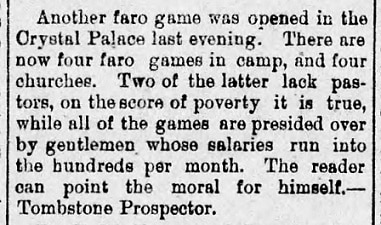
In 1888 Crystal Palace isn’t much mentioned. Local news on occasion, referencing people or unusual events. This history:
- Feb. 8, 1888: Tombstone Prospector reported a new sidewalk in front of the saloon, the same needed other places
- Same Date: Epitaph stated a Chinese man arrested for bringing a gun into the Crystal Palace
- April 12, 1888: Epitaph noted Julius Caesar to run the Crystal Palace!
We’re always researching Crystal Palace history. We’re open to information anyone provides. Please contact us about what you know!
Crystal Palace History 1889

In 1889, Julius Caesar is referenced with a Crystal Palace ad! A mysterious notice appears in the Tombstone Epitaph.
A short time later the startling event is unmasked in the Epitaph. A new singer, Miss Wood, enlisted to provide Crystal Palace entertainment. Creative marketing at its finest in historic 1880s!
The Crystal Palace had a raffle for a sewing machine: one of the newest inventions of the era!!

Toward year’s end, another singer hired. First mentioned in The Epitaph on November 22, 1889. Miss Cushman given notices in the paper under “Local Happenings.” The last one December 28, 1889.

Crystal Palace History
More Change for the 1890s
In the 1890s, the Crystal Palace had few mentions or ads in the Tombstone Epitaph. Instead their advertising went to The Tombstone Prospector. The Tombstone newspapers of the day, as well as the local businesses, historically aligned with each other politically.
(And yes, it’s the same way today!)
The Epitaph mentioned the Crystal Palace again when they reported an incident that occurred there. It horrified their editorial staff, and they commented, as well as reported on it. They asked for action!
On the same date, though, they also mentioned the Crystal’s singer: Annie Cushman. They noted she “is sure some swell singer.”
What do you think of that? Use our comment section below – to let us know!

The Epitaph mentioned the new Crystal Palace singer, Edith Smith. On May 31, 1890, noting she was a hit!
On Friday, June 7th they reported an incident surrounding her singing appearance. Two men admirers were drinking, lovingly watching her act. They vied for her attentions and one hit the other with a beer bottle. It cut his head so he needed stitches!
In early July the Tombstone Prospector specified that new singer, Miss Smith. They called it a Concert Hall! An effort to bring the public in for entertainment underway!

At the same time, an area behind the main bar was rented out to P.B. Warnekros for his enterprise, supplying the latest popular beer, Schlitz, along with ice keeping it cold. He advertised the Crystal Palace had great access to that beverage!

A surprise announcement appeared in both the local Prospector and Epitaph. The Crystal Palace under new management once again!
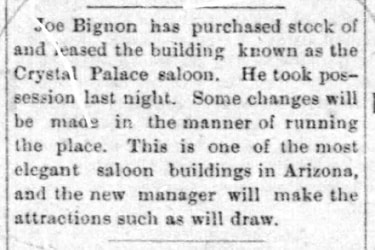

Deducing from the Tombstone Epitaph‘s announcements, they supported this change. Although there’s no ads, they begin mentioning the Crystal Palace again.


July 1890 saw an end to Crystal Palace’s advertising. From our history research, we can’t see Joe Bignon invested in much, if any, paid newspaper advertising.
He wasn’t against having free publicity any publication gave him! An occasional note surfaced in area periodicals. For instance, a new gambling game began at the Crystal Palace. The Tombstone Prospector noted it.

During 1891, from our history research, the Crystal Palace Saloon was locally mentioned only with a newsworthy occurrence. Such as these instances:
- February 1, an Epitaph article concerned well-known resident, C. Hattison of 8th Street. Found dead at home, surprising, at only 38 years old. Last seen healthy and well, three days prior at the Crystal Palace.
- Tombstone Prospector on 2/12/1891 wrote of miner Louis Holsey. Recently killed himself after killing his wife, in Kansas. In December 1890 Holsey ran a Crystal Palace Faro game a short time.
- The Weekly Epitaph also wrote up the Holsey incident, February 15. With more background on his family, and the situation. Some said he was quiet and solemn. Others said he’d threatened them. His wife was seeking a divorce, and soliciting evidence from Tombstone witnesses regarding his history of violence toward her.
- Sunday, May 31st Weekly Epitaph story about a local trial. During deliberations, a sheriff on the jury believed the defendant innocent. A locally unpopular opinion. He was violently accosted in the Crystal Palace.
Crystal Palace History: 1892
A Tombstone Epitaph notice told readers ice storage was still available at the back of the Crystal Palace. Operated by Southwestern Ice Company.

Manager, Joe Bignon sponsored a raffle. Maybe with a plan in mind, because two weeks later two announcements appear the same day in The Epitaph:
- Joe Bignon is retiring from the Crystal Palace.
- A separate Epitaph article stated the Crystal Palace will close for “extensive repairs.” Expected reopening date: July 1. An enormous undertaking making the Crystal a large venue!


But July 1 comes and goes, the Crystal Palace Saloon still closed. On July 24th An Epitaph article declares it will open soon. They’re working on wallpaper and ceilings.
Subsequently, there’s no announcement of a new owner. There’s no Crystal Palace Grand Opening. There’s no historical article located.
Finally a mention is given…
Crystal Palace History: 1893 to 1899

The Tombstone Epitaph prints a cautionary notice. But who’s responsible for solving this issue? And it’s now all the way into mid 1894!
On September 1 that year, the Arizona Weekly Citizen published a substantial analytical piece by someone with the byline “P.H.” entitled “Tombstone Today.” It speaks of “rows on rows of empty cabins.” And “whole blocks of saloons and stores of considerable magnitude forsaken.” It includes saloon names such as “Crystal Palace” and another celebrated, the “Fashion.”
Why? Its heading explains: “Tombstone has had a great decline.” And further, telling of silver’s price drop, miners and merchants leaving. They commend those left in Tombstone as hopeful and resilient.

The history conclusion can be, [we think] the Crystal Palace was to reopen after Bignon left. But financing fell through, so it never happened.
At 1895’s end, the Crystal Palace is finally mentioned in The Tombstone Epitaph. It’s sold, by a court judgment to Martin Costello.
Pittock published a story out of Phoenix on September 16, 1897. A historical look at Tombstone, it reviewed the current situation from its heyday. Listing the 1897 population about 1000. That’s a few hundred less than it presently has!
Pittock mentions the Crystal Palace. Saying the “corner last occupied by the Crystal Palace saloon, northwest corner of Fifth and Allen streets, less than three years ago retned [sic: rented] for $150 monthly.”4 So apparently the Crystal Palace was still not open in late 1897.
Researching news items to 1800’s end, nothing more is seen by us referencing Crystal Palace History in Tombstone Arizona.
Crystal Palace History: 1900s
An item appeared in Prescott’s Journal-Miner. Under “Saturday’s Daily” column. The Crystal Palace will reopen!
About that time, some rejuvenation happened in the Tombstone business community. As the Journal-Miner noted, that would be the eighth saloon in town.
On May 18, 1902 the Epitaph mentioned the outlook. Focusing on the Oriental Saloon refurbishment, reopening June 1st. Also mentioning the Crystal Palace expected to open.

Women Outlawed!
Another thing happened in May: women were outlawed from saloons! The result of “morality” political action running through the country. Men had the control, as women could not vote.
The Tombstone city council passed an ordinance, effective May 20, 1902. It stated: “no woman shall be allowed in the saloons or adjacent rooms, either as a guest or employee of the place.” Violation fines of $25 to $50, or imprisonment of 10 to 25 days.
However, note for the men’s convenience – it didn’t apply to the red light district! That area continued through January 1907, when prostitution was outlawed.
Crystal Renewed
It took a while, but work began on the Crystal. The Epitaph reported November 9, 1902 the remodeling: new ceiling work started. Anticipated opening date about a month away.
It didn’t go on time. Another announcement in The Epitaph December 21st, which named new owners. And the Grand Opening is announced, separately.


The Tombstone Epitaph printed their Grand Opening review on December 28th, reporting it “was well attended.” Calling it a favorable “class of resorts in the west.”
The Bisbee Daily Review July 26, 1903 issue said one Crystal Palace owner sold his interest. Elwood Madden moved on to “The Turf.” By September 1903, he’s ill with typhoid fever.
Early August 1903, John F. Anderson is a Crystal Palace proprietor. Did he replace Madden? Another proprietor is mentioned in a May 1906 Epitaph: Edward Wheeler. Then an August 1906 Epitaph announcement states only J.M. Speck remains as Crystal Palace management.


During 1907,
the Crystal Palace is mentioned, reporting travels of lease-owner, John M. Speck. In February visiting family in Los Angeles. In March visiting Silver City, New Mexico. In July traveling to Philadelphia for a convention. Afterwards returning to Silver City, where he’ll “remain for some time.”
That year Tombstone’s economy struggled.
No other Crystal Palace history reports were uncovered, until we hear of Speck’s marriage break-up. Somewhat strange circumstances. See it for yourself in the 1909 news clipping!

Crystal Palace History: 1910 – 1915
No reports are found early in the 1910 decade. A hint of what happened unravels from an Epitaph story published June 28, 1914. It mentions John Maddon [sic] returning to town.
They reminded readers he was the historic Crystal Palace owner, with John M. Speck. They note, “when the camp closed down several years ago the saloon was closed.” The wording indicates it closed after these owners were done with it.
The Crystal Palace property was then owned by Mary Costello, as her husband Martin died on September 15, 1911. Gambling was outlawed in Arizona starting 1907. The Costello estate sold their gaming tables and roulette wheels in 1915 to an establishment in Naco, Sonora Mexico .
Arizona passed prohibition January 1, 1915, even before it became the national law. Voters approved a Proposition in 1914, influencing what became of Tombstone’s saloons. Mary Costello sold the original, beautiful Crystal Palace bars.

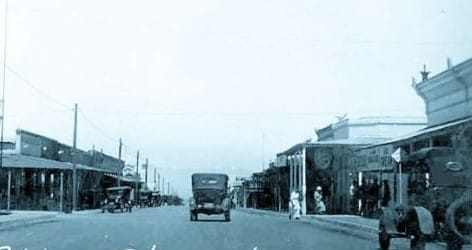
A Naco, Sonora saloon owner, F.J. Keogh, purchased the bar, back bar and all fixtures from the Crystal Palace Costello estate. Plus the huge ice box from the saloon’s rear. A truck carted it all across the border on June 2, 1923. The Crystal Palace bar was installed in the White House Saloon in Naco, Sonora. At some point unfortunately, that saloon succumbed to fire. The historic bar along with it!
What happens next?
Crystal Theatre Tombstone


January 1915, a whole new avenue for the Crystal Palace Saloon came into play. Joe Norcross took ownership of its lease. Joe expressed optimism for the town. Had The Crystal Theatre ready to go on February 26th, with a ball afterwards!
Then mid-year, he sold out to James and Tony Giacoma. Former miners, immigrants who arrived in town around 1909. They carried on the same type productions as did Joe.
Crystal Palace History:
1916 – 1922
Things looked up financially for the town. Not exactly booming, but more stable. Local mines consistently running, housing market full, hotel rooms booked, banks doing well. World War I began, contributing to this stability.
The U.S. didn’t get in the war until 1917. Tombstone was distracted with their patriotic effort.
At the war’s end, November 11, 1918, everyone celebrated! They gathered outside the Crystal Theatre while the Tombstone High School played the Star Spangled Banner. Local attorney W.G. Gilmore gave a short, moving commemorative speech.5
But again commercial town interests began to suffer. People moving away, until the population was just under 1000. Tombstone’s First National Bank: Mary Costello, President, almost closed! She acted to save it. But restaurants, stores, other enterprises were regularly closing.
The Commercial Club Secretary, Arlington Gardner, thought of something to save the town: tourism! Mid 1919 Author Frederick Bechdolt came to town, meeting with Gardner. This fomented Saturday Evening Post articles about Tombstone AZ. Then a book, When the West Was Young. While in town, he promoted restoring Boothill cemetery.
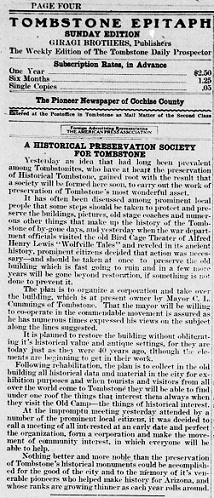

In 1922, the Giacoma brothers felt the buzz. They refurbished the Crystal Theatre. The Epitaph mentioned others along Allen Street got into the action! The Bisbee Daily Review and Tucson’s Arizona Daily Star featured this news.
At year’s end the Crystal Theatre still operated. The El Paso Herald published an article December 9, 1922 reviewing Tombstone’s history. It mentioned the “Crystal Palace gambling hall is a prosaic Crystal theater, showing moving pictures…”
Crystal Palace History: 1923 & Beyond
Gardner enlisted help from Tombstone historian George H. Kelly. They decided to commemorate a 50-year anniversary in 1929. Scheduled for October: the first “Helldorado.”
Twenty-four committees planned it, meeting at the Crystal Palace. Among the preparations:
- refurbish historic buildings
- block auto traffic from downtown
- plan performances
- open the Bird Cage as a vaudeville venue
- AND restore the Crystal Palace as the saloon it was in the Wild West era
- Except the Crystal Palace could only sell soft drinks, because of Prohibition (which didn’t end until 1933).
The most popular reenactment was The Gunfight at the O.K. Corral. That feature made newspapers throughout the country.
Over 6,400 people were in town for the event. Even so the Phoenix Gazette was a naysayer. Was it a one-time event for a dying town? “…the final curtain has dropped in the Bird Cage and the last lights have gone out in the Crystal Palace.”
The big stock market crash that week probably influenced that feeling! Mining barely held on; up a little, then down again over the years. Depression years were severe for those in town. Tombstone lost the County Seat to Bisbee in 1930. Historically another severe hit!
But that year, Tombstone resident Walter Lombardi bought the Crystal Palace.
Tourists visited Tombstone via the new cross-country auto route: U.S. Hwy. 80. Called Broadway of America. Tombstone became a well-known stopping point.
In 1936 Gardner, the Coles, with other pioneer Tombstoners: Mary Costello, Ethel Macia and Margaret Cummings, continued promoting Tombstone’s history. Including the Crystal Palace, the Bird Cage, Boothill, Nellie Cashman’s hotel, the world’s largest rosebush, Schieffelin Monument, the Courthouse and others.
With U.S. WWII entry in 1941, Tombstone’s population was only 822. Another terrible economic time. Mining was virtually done. Vintage buildings on sale for bargain rates! Another tourist revival was sought after the war ended. In 1948, a travel boom on U.S. Hwy. 80 saw travelers return.
Another historic Crystal Palace Saloon refurbishment. Lombardi hired Alan Branson of Associate Artists and Decorators of Tucson for back bar recreation. A Grand Opening on May 8 & 9, 1948. The Epitaph‘s May 13, 1948 write-up gave descriptive accolades: “grandeur and splendor for which it was noted during the heyday of Tombstone.”
In 1950, Lombardi was involved on the new Tombstone Restoration Commission. Governor Garvey came to town for a banquet. Reenactments were staged, Rudolf Valentino’s silent film Son of the Sheik was shown in the Crystal Palace Theater.
A close call on Allen Street on May 23, 1957! Starting in back of the Cattleman & Miner’s Bar, flames seared down the street. Approaching the Crystal Palace, nearly got it before being extinguished.
Three men from the Eastern U.S., interested in history, and in making money, formed Historic Tombstone Adventures. Around 1963 they purchased numerous consequential properties.
Their first priority was the Crystal Palace Saloon. They reworked the outside for historic authenticity. As in 1882, with second story rooms. The refurbishment took five months. For purchase and renewal, it cost $190,000.2
The historic Crystal Palace has shifted ownership more times since. The importance of Crystal Palace History as a Saloon and then a theater in Tombstone’s ongoing adventure is something you can relive today.
Stop in to envision what’s occurred there over the years. See the re-creation of the beautiful, historic bar & back bar. Take photos, and Give Us A Look at them, if you would!! Visit Tombstone to live Wild West history!
References
1 Weekly Republican (31 Oct., 1879). From Tuesday’s Daily Herald. P. 4. Phoenix, AZ.
2 Bailey, L.R. (2004). Too tough to die. Westernlore Press. Tucson AZ
3 Weekly Epitaph (1882, July 23). Tombstone, Arizona.
4 Arizona Republic (1897, Sept. 16) P. 4. Phoenix, AZ
5 Tombstone Prospector (1918, November 11). Tombstone, AZ
6 Cannon, J.A. (2021, Feb. 28). Crystal Palace. World Encyclopedia. Retrieved from encyclopedia.com/environment/encyclopedias-almanacs-transcripts-and-maps/crystal-palace
All Newspaper clippings retrieved from our subscription at Newspapers.com
